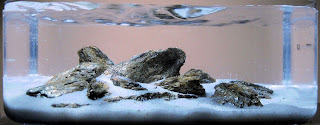Lagarosiphon major
Lagarosiphon major
(H.N. Ridley, 1928)
Pianta acquatica a stelo molto particolare. Vive bene in acqua fredda e risulta idonea sia all'acquario sia al laghetto. Ha un grande potere ossigenante/depurante ed è molto invasiva.
----------o----------
Nome scientifico:
Lagarosiphon major (syn. Elodea crispa )
Common names:
Plague of water arched
Curly Waterweed
African Oxygen Weed Elodea
African curly leaved waterweed
Family: Hydrocharitaceae
Source:
Africa (the species is native to southern Africa, but because of man's was able to colonize over time many other areas geographical, even very far from their native territory, Lagarosiphon major example is reported in central and northern Italy, lying north, and in some states of Oceania, particularly New Zealand).
Here are two photos taken by me in the river Ticino, Lombardy. The second I think a thousand words to explain how this plant can cause problems in case of slow-moving river, going as far as to prevent their airworthiness.
Morphology:
aquatic plant stand, green medium / dark. The leaves are long, about 12 / 20 mm wide and 2 / 4 mm, real seem bent down, almost closed in on themselves, and are arranged spirally on the stem, forming a virtually unbroken line attachment that wraps tightly around the stem . In suitable conditions the foliage is very thick and the stem is not even visible.
In nature, drums, depending on current conditions, can reach lengths in the order of 5 / 6 yards, in this caso però il fogliame sarà presente solo sulla parte superiore del fusto, laddove vi sia luce da sfruttare, mentre la parte centro inferiore del fusto risulterà completamente spoglia.
La Crescita:
tasso di crescita medio/rapido a seconda delle condizioni offerte. Grazie alle sue radici rizomatose questa pianta riesce a colonizzare rapidamente grandi aree di fondale, cotinuando a produrre nuovi steli che in pratica emergeranno direttamente dal fondo.
Valori Acquario:
PH: 6,5 / 8,0
GH: 3 / 15 °dGH
temperature *: 14 / 24 ° C
Light: medium to strong
* Note: Lagarosiphon major is a perennial, it survives even the harshest winters and the freezing of water, thanks to this its great capacity to regenerate itself on the high concentration of stem cells in the stem, with a view aquarium is only right for me but only to advise the temperature range that allows the plant to maintain a decent appearance. In this sense therefore did not indicate such a value range of 0 / 27 ° C as I could have done, in fact the plant to 14 / 15 ° C gradually begins to defoliation (from the bottom), while at temperatures above 24 ° C is in vegetative stasis, and prolonged exposure to rot and die. Therefore the board to remain in the range 14 / 24 ° C, optimum 17 / 21 ° C.
Aquarium Equipment:
bottom soft and porous, preferably fine-grained and mature. The water must move a little or even stagnant. The presence of nutrients in the background is not essential, the plant grows well from my experiences even on aggregate (but very mature!), Provided the temperature is right and light enough, however, nothing precludes it from taking an active fund, that certainly will not hurt. The same goes for the possibility of a CO2 system, it is not essential but if you take can make a difference in the quality of the foliage and growth rate.
Fertilization:
Lagarosiphon major feeds both on the leaves as well as by radical, however, has no special needs and is growing decently even in the absence of a dedicated and fertilization on properties of inert Logically, however, a good fertilizer, complete and balanced, can make a difference in the quality of the foliage and growth rate. A limiting factor for this plant is spesso il Ferro, che se carente può sensibilmente rallentarne la crescita.
Posizione In Acquario:
pianta da sfondo, ideale per la parte posteriore dell'allestimento.
Modalità di Riproduzione:
si tratta di una pianta a riproduzione dioica, questo significa che ne esistono esemplari maschili ed esemplari femminili, a seconda del sesso cambia l'infiorescenza. I fiori maschili sono detti stami e rilasciano polline (gameti maschili), quelli femminili sono detti pistilli e non possono essere fecondati senza la presenza di polline rilasciato inflorescences from male specimens. The flowers are formed on the surface, it being raised, and pollination usually takes place at the end of the summer season. The problem is that only native habitat (southern Africa) are specimens of both sexes, while in other regions that were subsequently colonized by this plant are found to contain only female specimens. However this plant is still much more invasive in nature in that it has a high regenerative capacity of its fabrics, its trunk is a large amount of stem cells through which is just a small piece of stem, including the first fully foliage to give the way for the formation of a new full copy. In practice, it reproduces by fragmentation and assure you that in its invasive nature is leading to various problems (hence the common name "water arch fever"), to the point that in many states it is forbidden to import and its release in nature is considered a crime. When this plant invades a stretch of river or pond habitat for the consequences can be very serious, is a wetland plant, releasing plenty of oxygen and that if allowed to grow freely invade the entire space completely obscuring all the other plants. In
aquarium is rather easy to manage, you can move or propagate it to your liking, the method to cuttings, or just partially burying the pieces of shell.
the aquarium:
I am not aware that this plant is present in the list of the most renowned companies in the sector, then you'll find it in glass or fans will presumably be willing to cedervela pruning (cuttings). To put it in your aquarium will be sufficient individually planted the stalks, leaving maybe two or three inches of space between them.


















































